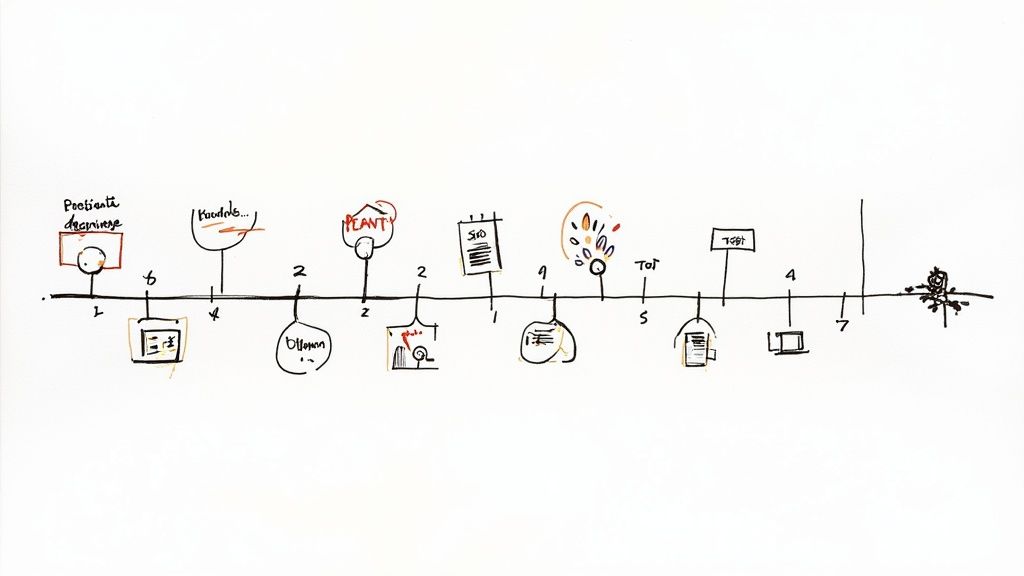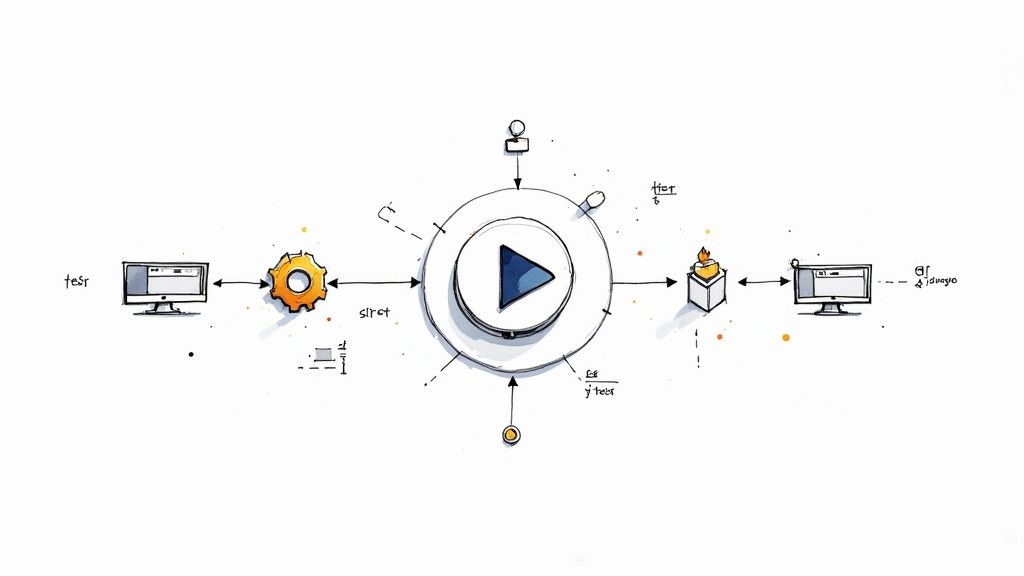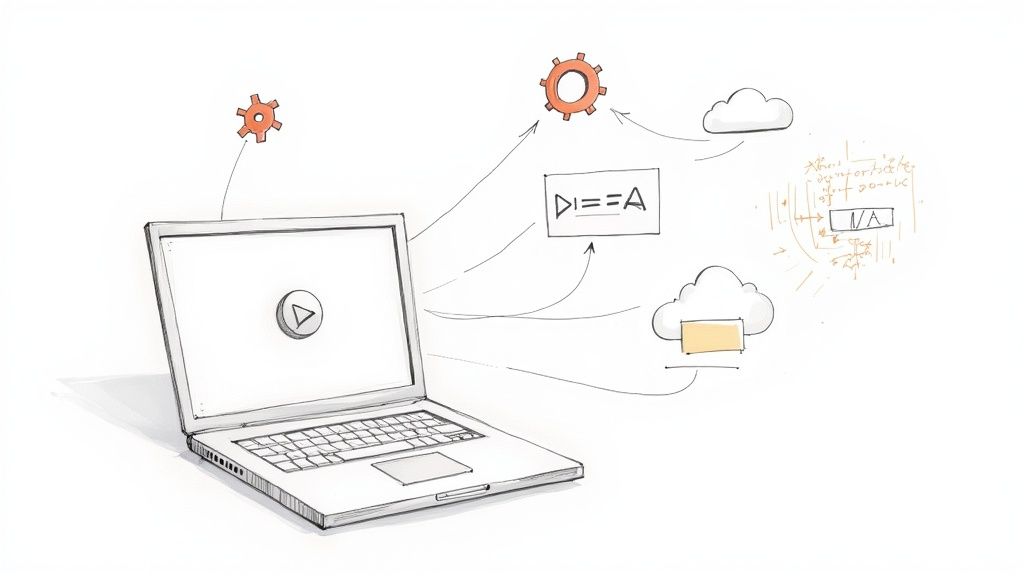Test Development Driven: A Strategic Guide for Building Better Software

The Evolution of Test Development Driven Excellence

Software testing has come a long way in recent years. What was once treated as a final quality check has become central to how we build software from day one. This approach, known as test development driven (TDD), puts testing at the forefront of development - a major shift from the old way of testing code after it was written.
From Verification to Design
In the past, testing mainly checked if software met its requirements. Finding bugs late in development led to expensive fixes and delays. TDD flips this around by using tests to shape the design from the start. Developers write tests before the actual code, which helps them think through how features should work.
Take building an automatic pull request batching feature in Mergify. With TDD, you'd first write tests for different scenarios - handling multiple PRs, branch setups, and merge conflicts. This early testing helps spot potential issues and encourages writing code that's easy to test and maintain.
The Rise of TDD and Its Impact
Methods like Extreme Programming (XP) and Agile have helped make TDD more common. These approaches focus on quick feedback and frequent updates, which fits perfectly with TDD's principles. Tools like JUnit make it practical to write and run tests efficiently as part of daily development work.
The idea of using tests to guide development isn't entirely new. Consider standardized testing in education - a practice that's been around for over 100 years in the United States. Despite ongoing debates, these tests continue to shape education due to factors like America's decentralized school system and focus on merit-based advancement. For more background, check out this research on the history of standardized testing. Just as standardized tests aim to improve education, TDD helps create better software.
Embracing a Test-First Culture
Making TDD work requires changing how development teams think about quality. Teams need to see testing not as extra work, but as a way to build better software from the start. This mindset gives developers confidence to improve code, knowing their tests will catch any problems early. The result? More reliable software that better serves its users.
Creating a Test-First Development Culture That Sticks

Making testing an essential part of development requires more than just writing tests. It means integrating testing deeply into how your team works and thinks. The key is seeing testing not as a final checkpoint, but as a vital tool that shapes how we design and build software.
Shifting Team Perspectives
Many developers are used to testing after writing code. Changing this mindset takes time and clear communication about why testing first matters. Show your team concrete examples of how writing tests first leads to better code structure and fewer bugs. When developers see how much less time they spend debugging, they often become strong advocates for test-first development.
Getting the whole team involved in testing creates shared ownership of code quality. Writing tests before implementation helps everyone agree on how the software should work. This shared understanding prevents confusion and reduces bugs that come from unclear requirements or miscommunication.
Establishing Sustainable Testing Protocols
For test-first practices to last, you need clear guidelines. Set specific standards for test coverage and decide which types of tests work best for different situations. Using tools like Mergify for automated merge queues helps ensure all code changes pass tests before joining the main codebase.
The software testing industry continues to grow, showing how important quality assurance has become. Market research indicates the field will reach $67.56 billion by 2030, with 5.12% yearly growth. Learn more at Software Testing Market Research. This growth shows why teams must keep improving their testing approaches to match industry standards.
Fostering Continuous Improvement
Keeping a test-first culture strong requires regular evaluation. Get feedback from your developers, look at test results, and keep refining your process. This might mean updating your testing tools, adjusting your testing approach, or finding better ways to handle specific testing challenges.
Regular improvements help keep testing relevant and effective. When teams consistently evaluate and update their testing practices, they deliver better software more reliably. Good testing makes development more efficient and leads to higher quality products that users can depend on.
Mastering Test Data Management for Modern Development

Getting test data management right is essential for software testing success. Teams need access to relevant test data that's properly formatted while maintaining security and compliance. As applications grow more complex, managing test data becomes increasingly challenging.
Understanding the Challenges of Test Data Management
Test data needs vary significantly across different testing phases. While unit tests may only require small data samples, system tests need comprehensive datasets that mirror production. Managing test data across dev, staging and production environments adds another layer of complexity. Tools like Mergify help teams handle these challenges through automated merge queues that maintain consistent test data flow.
Data privacy requirements like GDPR make proper handling of sensitive information critical. Teams must implement data masking and anonymization as core parts of their test data strategy. Poor quality or outdated test data can also undermine testing effectiveness by producing unreliable results.
Strategies for Effective Test Data Management
Several proven approaches can help address these test data challenges. Data virtualization creates safe copies of production data for testing without duplicating sensitive information. Data masking replaces real data with realistic substitutes to enable thorough testing while protecting privacy. For larger needs, synthetic data generation produces artificial datasets with production-like characteristics.
The test data management market reflects growing demand for these capabilities. Current estimates value the market at $1.3 billion, with projections showing growth to $2.7 billion by 2030 at a 11.3% annual rate. See the full market analysis here.
Implementing Robust Test Data Management Practices
A solid test data management approach requires:
- Clear data governance policies: Define rules for accessing, using and storing test data
- Automated data provisioning: Set up tools to quickly generate and distribute needed test data
- Centralized test data repository: Maintain a single source of truth for all test data
- Data quality monitoring: Regular validation to ensure test data stays accurate and useful
With proper test data management in place, teams can conduct more effective testing and deliver higher quality software more quickly and reliably.
Building Test Automation Frameworks That Scale

Strong test automation frameworks are essential for effective test-driven development. A good framework does more than just run automated tests - it needs to grow with your project while staying easy to maintain and update. This means taking a structured approach rather than just writing test scripts.
Designing for Maintainability and Scalability
When building your test framework, plan ahead for future needs. Start by picking tools that match your tech stack and can adapt as your application changes. For example, if you use microservices, you'll want a framework that can handle distributed testing rather than a monolithic setup.
Think of framework design like building with LEGO blocks - small, reusable pieces are better than one big chunk. Break your tests into logical modules, use clear naming, and create reusable components. This makes it much easier to fix issues and update the framework as needed.
Integrating With CI/CD Pipelines
Link your test framework to your CI/CD pipeline to enable true test-driven development. This runs tests automatically when code changes, giving quick feedback and catching bugs early. Tools like Mergify help manage testing of pull requests before they're merged. This automation keeps code quality high and helps teams move faster.
Set up your test environment to deploy and configure automatically too. This removes manual work, prevents mistakes, and ensures consistent testing across environments. You'll get valuable insights about code quality with each build, helping catch issues before they reach production.
Avoiding Common Pitfalls
Test automation often fails due to poor planning, wrong tool choices, or lack of maintenance. Start with a clear plan that outlines your goals and framework scope. Make sure your team has the skills and resources needed to build and maintain the framework over time.
New tech brings new testing challenges too. Take IoT testing - it's expected to grow from $1.89 billion in 2023 to $21.99 billion by 2032, with 31% yearly growth. See more trends in the Global App Testing report. Your framework needs to handle both current and future testing needs.
Focus on maintainability, scalability, and solid CI/CD integration. This creates test automation frameworks that truly support test-driven development and help your software projects succeed long-term.
Measuring and Optimizing Test Effectiveness
Good testing requires focusing on real impact rather than just tracking numbers. Teams need to identify key performance indicators (KPIs) that show whether testing is actually working. Let's explore how leading teams measure and improve their testing approach.
Identifying Meaningful Coverage Metrics
Code coverage alone doesn't guarantee quality software - even 100% coverage can miss critical bugs. Instead, focus your testing on the most important areas like:
- Parts of code that have had frequent bugs
- Features handling sensitive data
- Complex business logic
- Critical user paths
Consider using mutation testing to check if your tests can catch real code changes. This helps ensure your tests are truly effective, not just hitting basic coverage targets.
Tracking Quality Improvements Over Time
To understand if testing is helping, track concrete metrics like:
- Number of bugs found in each testing phase
- Time needed to fix issues
- Reduction in production incidents
- User-reported problems
This data helps teams spot trends, find weak spots, and prove the value of good testing. For example, seeing fewer production bugs after adding more thorough testing shows clear benefits. Just as schools use testing to check student progress (as discussed in this education testing research), software teams need ways to measure quality improvements.
Demonstrating the Business Impact of Testing
Testing needs to support business goals by:
- Reducing costs from fixing bugs
- Improving customer satisfaction
- Enabling faster, more confident releases
Tools like Mergify help by automating testing workflows and making releases smoother. Connect your testing metrics to these business outcomes to show the real value of your testing efforts.
Frameworks for Continuous Improvement
Use the Plan-Do-Check-Act (PDCA) approach to regularly:
- Review current testing processes
- Identify areas needing improvement
- Make and test changes
- Check if changes helped
Regular team feedback is crucial - encourage open discussion about what's working and what isn't. When teams work together to constantly improve testing, they deliver better software more consistently.
Future-Proofing Your Test Development Strategy
To stay competitive in software development, teams must regularly update their testing approaches. This means identifying valuable new trends and methods, while thoughtfully incorporating them into existing workflows.
The Impact of AI on Testing
AI is changing how teams approach software testing. New AI tools help automate test creation, running tests, and analyzing results - giving human testers more time for complex work. AI can also predict where bugs are likely to occur by analyzing code changes, helping teams test more strategically. For test data needs, AI assists in creating synthetic data to reduce dependency on production data. Tools like Mergify demonstrate these concepts through smart merge queues and CI batching.
Emerging Testing Methodologies
New testing approaches are gaining popularity beyond AI. Shift-left testing moves testing earlier in development to catch issues sooner when they're cheaper to fix. Continuous testing within CI/CD pipelines provides quick feedback on code changes. Both methods help teams move faster while maintaining quality standards.
Evaluating and Adopting New Testing Technologies
Adding new testing tools requires careful planning. Rather than chasing every new trend, focus on understanding your team's specific challenges first. Assess potential solutions based on how well they address your needs and work with your current tools. Start with small pilot projects before broader rollouts. This measured approach helps ensure new tools actually improve your testing effectiveness.
Preparing Your Team for the Future of Testing
Success in testing requires ongoing learning. Give your team opportunities to explore new testing approaches and tools. Support skill development through training and resources. Build a team culture that welcomes smart experimentation while maintaining high standards. This balanced approach helps teams stay current with testing best practices while delivering reliable software.
Want to improve your development process and code quality? See how Mergify can help your team excel at test-driven development.





